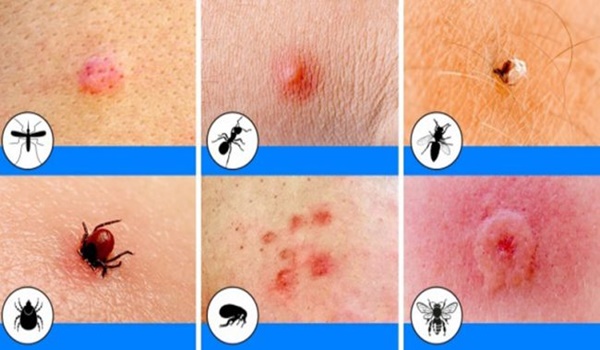We all love the long and hot summer days and even more pleasant and relaxing summer nights, and it seems that the annoying bugs that fly all around us are our biggest enemy.
Today, we will teach you how to identify the most common bug bites in North America, in order to help you avoid them and treat them with ease:
Mosquitos

Mosquitos usually live in the tall grass close to areas that humans inhabit and adore standing water such as pools, ponds, bird baths, and clogged rain gutters. Their bites cause red, itchy welts which last for a couple of days.
Bees

When it stings, the bee stabs its barbed stinger into the skin, and bee venom contains proteins that affect skin cells and the immune system, leading to pain and swelling to the sting area.
These bites are not dangerous, but if you experience signs of anaphylactic shock, you should immediately seek medical attention, as you might be allergic to bee venom. In order to prevent this, avoid being in close proximity to a beehive, and do not wear floral clothes if you spend the day outdoors, at a picnic or barbecue.
Wasps

The venom of the wasp causes pain and swellings as well, but the difference is that wasps can sting you more times, while bees sting only once. If you have a wasp allergy, you will experience sharp pain and burning at the site, as well as swelling of the face, throat, or lips, nausea, and a drop in blood pressure.
In order to avoid wasps, do not go near a hive, where they build small nests in the spring to lay their eggs, and during the summer, be careful when you are near garbage cans and picnic sites.
Spiders

Spiders are everywhere around us, and their bites leave a small, red welt on the skin where the spider has injected the venom. The bites can be painful or itchy.
Ant Bites

The sting of fire ants causes intense pain. They live in mounds or nests that are about 1 foot high, usually in grassy areas like pastures and lawns. Their bites turn into yellowish blisters or red pustules that are raised with a red base and are very itchy and painful. After bursting, they expel a clear liquid.
Fleas

Fleas bite us as well, and not just our furry friends, Most people tend to associate fleas with our furry canine friends and leave little red, itchy, and sore bites, usually around the ankles or legs, in groups of three and four. They jump from place to place fast and multiply very quickly.
Bed Bugs

Bed bugs live in furniture, and feast on our blood. They usually come out at night in order to feast, and their bites are very small, red, itchy bumps on the body.
Deer Flies

The bite of these pesky little bugs is very painful. They are usually found around lakes, swamps, and other bodies of water in spring. When they bite, they leave red bumps or welts on the skin behind and can transmit a rare disease known as rabbit fever.
Ticks

Ticks are nasty little bugs, which attach themselves to mammals in order to suck their blood, which helps them increase in size. They are usually found in long grass, trees, shrubs, and leaf piles, and are usually harmless, but can sometimes be dangerous, by passing on diseases between animals and humans. They usually prefer moist body areas like the groin and armpits.
Lice
There are three kinds of lice that feed on human blood: head lice, pubic lice, and body lice, and the first two use the skin and hair as a nesting ground, while the body lice live on fabric. They crawl and are spread through physical contact with an infected person. Their bites are small, red, and very itchy, and can get infected by scratching.
The following tips can help you avoid insect bites and stings:
- When you spent your time outdoors, make sure you always wear shoes
- If you notice bees or wasps, try to remain calm and move away slowly, do not wave your arms around or swat at them
- Be careful when you are around flowering plants, rubbish, compost, stagnant water, and in outdoor areas where food is served
- To prevent insects from entering the home, keep your doors and windows closed or put thin netting or door beads over them
- Cover the exposed skin when you are outside by wearing long trousers and sleeves, especially at sunrise or sunset, as insects are very active then
- Avoid camping near stagnant water, like ponds and swamps, as most insects adore areas found near water
- When having a picnic or eating and drinking outside, make sure all the food and drink are covered, particularly sweet things – as wasps or bees can get into open drink bottles or cans
- Apply insect repellent to exposed skin when outdoors, and choose repellents that contain 50% DEET (diethyltoluamide)
- Never disturb insect nests
- Insects can be attracted by scents from deodorants, shampoos, and soaps, so avoid using products with strong perfumes
Yet, we cannot get rid of all insects around us, so it would be better to learn how to handle the symptoms of their bites:
- Apply Aloe Vera gel onto the affected area to soothe the bites
- Place a soaked cold tea bag on the affected area, to calm the itching and fight the inflammation
- Essential oils such as lavender, peppermint, camphor, and tea tree oil alleviate the irritations, swelling, and itching. Apply them diluted in coconut oil on the skin to calm it
If you follow these tips, we are sure you will definitely enjoy this summer more than you did last year!


